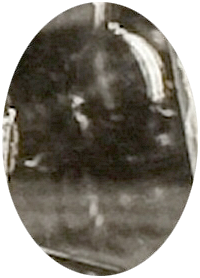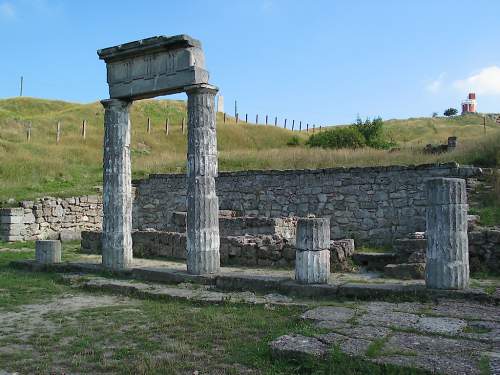|
Henrik Wigström
Henrik Immanuel Wigström (2 October 1862 – 14 March 1923) a Finnish silver & goldsmith, was one of the most important Fabergé workmasters along with Michael Perchin. Perchin was the head workmaster from 1886 until his death in 1903, when he was succeeded by his chief assistant Henrik Wigström. These two workmasters were responsible for almost all the imperial Easter eggs. Erik August Kollin, a Finn, was head work master from 1870 to 1886 and produced gold jewellery, including pieces in the Scythian style (the Scythian treasure had just been discovered at Kerch in the Crimea). August Wilhelm Holmström (who had been appointed head jeweller by Gustav Faberge in 1857) was born in Ekenäs, Finland. Henrik Wigström was born in Ekenäs, Finland, and was apprenticed to a local Danish born goldsmith named Petter Madsén, a successful manufacturer of silverware who was familiar with the jewellery trade in St. Petersburg, as at one time he had had a workshop there. Once in Mads� ... [...More Info...] [...Related Items...] OR: [Wikipedia] [Google] [Baidu] |
Michael Perchin
Michael Evlampievich Perkhin (; 1860-1903) was a Russian jeweler. Born in Prionezhsky District, Okulovskaya in Olonets Governorate (now Republic of Karelia), he moved to St. Petersburg, he joined the House of Fabergé. With Henrik Wigström, he was one of the two leading workmasters of the House of Fabergé. Career Perkhin became the leading workmaster in the House of Fabergé in 1886 and supervised production of the eggs until his death in St. Petersburg in 1903. The eggs he was responsible for were marked with his initials. He worked initially as a journeyman in the workshop of Erik August Kollin. In 1884 he qualified as a master craftsman and his artistic potential must have been obvious to Fabergé who appointed him head workmaster in 1886. His workshop produced all types of ''objets de fantaisie'' in gold, vitreous enamel, enamel and hard stones. All the important commissions of the time, including some of the Imperial Easter Eggs, the renowned "Fabergé eggs", were m ... [...More Info...] [...Related Items...] OR: [Wikipedia] [Google] [Baidu] |
Fabergé Egg
A Fabergé egg () is a jewelled egg first created by the jewellery firm House of Fabergé, in Saint Petersburg, Russia. As many as 69 Czarist Russia Era eggs were created, of which 61 are currently known to have survived. Virtually all of the original first edition eggs were manufactured under the supervision of Peter Carl Fabergé between 1885 and 1917. The most famous of the firm's creations are the 50 delivered Imperial Easter eggs, of which 44 are currently known to be in complete or partial physical existence, leaving the fate of those remaining unknown. These eggs were commissioned for the Russian tsar Aleksandr III (10 eggs) and tsar Nikolai II (40 eggs) as Easter gifts for Alexander's wife and Nicholas's mother Empress Maria Feodorovna, and Nicholas's wife Tsaritsa Alexandra Feodorovna. Fabergé eggs are worth large sums of money and have become symbols of opulence. Two more of Fabergé Easter Imperial eggs (bringing the total to 52) were designed but were unable ... [...More Info...] [...Related Items...] OR: [Wikipedia] [Google] [Baidu] |
Erik August Kollin
Erik August Kollin (28 December 1836 – 1901) was a Finnish jeweler who worked for Fabergé in St. Petersburg. Kollin was born in Pohja in southwest Finland. He studied as a journeyman with gold and silversmith Alexander Palmén in Ekenäs in 1858 before travelling to St. Petersburg. He qualified as workmaster in 1868 at August Holmström's workshop, and in 1870 opened his own workshop in St. Petersburg. Kollin worked for August Holmström and for Carl Fabergé, and was soon put in charge of all Fabergé workshops, a post he held until 1886 when he was replaced by Michael Perkhin Michael Evlampievich Perkhin (; 1860-1903) was a Russian jeweler. Born in Okulovskaya in Olonets Governorate (now Republic of Karelia), he moved to St. Petersburg, he joined the House of Fabergé. With Henrik Wigström, he was one of the tw .... He was Fabergé's first chief jeweler. Specialized in gold and silver articles, most of them in an archaic style of the period. The artefacts prod ... [...More Info...] [...Related Items...] OR: [Wikipedia] [Google] [Baidu] |
Kerch
Kerch, also known as Keriç or Kerich, is a city of regional significance on the Kerch Peninsula in the east of Crimea. It has a population of Founded 2,600 years ago as the Colonies in antiquity#Greek colonies, ancient Greek colony Pantikapaion, Kerch is one of the most ancient cities in Crimea. The city experienced rapid growth starting in the 1920s and was the site of Battle of the Kerch Peninsula, a major battle during World War II. Today, it is one of the largest cities in Crimea and is among the area's most important industrial, transport and tourist centres. As with the rest of Crimea, it has been occupied by Russian forces since the Annexation of Crimea by the Russian Federation, Russian annexation of Crimea in 2014. History Ancient times Archeological digs at Mayak village near the city ascertained that the area had already been inhabited in the 17th–15th centuries BC. While many finds from Kerch can be found in the Hermitage Museum in St Petersburg and the loc ... [...More Info...] [...Related Items...] OR: [Wikipedia] [Google] [Baidu] |
Crimea
Crimea ( ) is a peninsula in Eastern Europe, on the northern coast of the Black Sea, almost entirely surrounded by the Black Sea and the smaller Sea of Azov. The Isthmus of Perekop connects the peninsula to Kherson Oblast in mainland Ukraine. To the east, the Crimean Bridge, constructed in 2018, spans the Strait of Kerch, linking the peninsula with Krasnodar Krai in Russia. The Arabat Spit, located to the northeast, is a narrow strip of land that separates the Syvash lagoons from the Sea of Azov. Across the Black Sea to the west lies Romania and to the south is Turkey. The population is 2.4 million, and the largest city is Sevastopol. The region, internationally recognized as part of Ukraine, has been under Russian occupation of Crimea, Russian occupation since 2014. Called the Tauric Peninsula until the early modern period, Crimea has historically been at the boundary between the Classical antiquity, classical world and the Pontic–Caspian steppe, steppe. Greeks in pre-Rom ... [...More Info...] [...Related Items...] OR: [Wikipedia] [Google] [Baidu] |
August Wilhelm Holmström
August Wilhelm Holmström (2 October 1829 – 1903) was a Finnish silversmith, silver- and goldsmith. Born in Helsinki, Finland, he became an apprentice at the workshop of jeweller Karl Herold in St. Petersburg 1845—1850, master in 1857 with his own workshop. Senior member of Fabergé's workshop, he was head jeweller and also produced parts for composite articles. He died in St. Petersburg. His son Albert Holmström (1876—1925) continued in his father's footsteps after his death and used the same mark, ''AH''. His daughter Hilma Alina Holmström (1875—1936) and granddaughter Alma Pihl (1888—1976) were both jewellery designers and workmasters at Fabergé. Alma designed the Winter (Fabergé egg), Winter Easter Egg and the Mosaic (Fabergé egg), Mosaic Easter Egg. Grandson Oskar Woldemar Pihl (1890—1959) was also a jeweller and goldsmith. References Sources * G.von Habsburg-Lothringen & A.von Solodkoff, ''Fabergé - Court Jeweler to the Tsars'' (1979) * Geoffre ... [...More Info...] [...Related Items...] OR: [Wikipedia] [Google] [Baidu] |
Ekenäs (Finland)
Ekenäs, composed of the Swedish language, Swedish words ''ek-'' (''oak'') and ''näs'' (''promontory'' or ''peninsula''), is a place name in Fennoscandia. In particular it refers to: * Ekenäs, Finland, a town in the municipality of Raseborg, formerly an independent city * Ekenäs Castle in Linköping Municipality, Sweden * Ekenäs, Kalmar, a village in Kalmar Municipality, Sweden See also * Ekenäs Idrottsförening, a sports club from Ekenäs, Raseborg in Finland {{dab, geodis ... [...More Info...] [...Related Items...] OR: [Wikipedia] [Google] [Baidu] |
Finland
Finland, officially the Republic of Finland, is a Nordic country in Northern Europe. It borders Sweden to the northwest, Norway to the north, and Russia to the east, with the Gulf of Bothnia to the west and the Gulf of Finland to the south, opposite Estonia. Finland has a population of 5.6 million. Its capital and largest city is Helsinki. The majority of the population are Finns, ethnic Finns. The official languages are Finnish language, Finnish and Swedish language, Swedish; 84.1 percent of the population speak the first as their mother tongue and 5.1 percent the latter. Finland's climate varies from humid continental climate, humid continental in the south to boreal climate, boreal in the north. The land cover is predominantly boreal forest biome, with List of lakes of Finland, more than 180,000 recorded lakes. Finland was first settled around 9000 BC after the Last Glacial Period, last Ice Age. During the Stone Age, various cultures emerged, distinguished by differen ... [...More Info...] [...Related Items...] OR: [Wikipedia] [Google] [Baidu] |
Ekenäs, Finland
Ekenäs (; ) is a town and former List of cities and towns in Finland, municipality in Finland that comprised the former municipalities of Snappertuna and Tenala together with the town of Ekenäs. It was merged with Pohja and Karis to form the new municipality of Raseborg on January 1, 2009. Ekenäs is in the provinces of Finland, province of Southern Finland, and is part of the Uusimaa (region), Uusimaa () regions of Finland, region. The town had a population of 14,754 (as of 31 December 2008) and covered a land area of . The population density was . The town is bilingual, with the majority being Finland-Swedish, Swedish speakers (81%), and the minority Finnish language, Finnish speakers (17%). History Ekenäs is Finland's seventh oldest town and the first of the non-medieval towns. King Gustav Wasa granted town rights to Ekenäs on 15 December 1546, but even before that Ekenäs played a significant role in maritime transport. Today it is mostly noted for its archipelago, part ... [...More Info...] [...Related Items...] OR: [Wikipedia] [Google] [Baidu] |
Terijoki
Zelenogorsk (), known as Terijoki prior to 1948 (a name still used in Finnish and Swedish), is a municipal town in Kurortny District of the federal city of St. Petersburg, Russia, located in part of the Karelian Isthmus on the shore of the Gulf of Finland. Population: It has a station on the St. Petersburg-Vyborg railroad. It is located about northwest of central Saint Petersburg. History From 1323 to 1721 the Zelenogorsk area was a part of Sweden. It was ceded to Russia in 1721, becoming " Old Finland", which again was united with the Grand-Duchy of Finland in 1811. Until 1917, Terijoki was part of the Grand-Duchy of Finland, ruled by the Grand Dukes of Finland, who were the Tsars of Russia, (1812–1917). Even though all of Finland was part of the Russian Empire, a customs border was located at Terijoki. A valid passport was needed for crossing the border between Russia and the Grand Duchy of Finland. Vladimir Lenin managed to travel in secrecy over the inter ... [...More Info...] [...Related Items...] OR: [Wikipedia] [Google] [Baidu] |
Hardstone
Hardstone is a non-scientific term, mostly encountered in the decorative arts or archaeology, that has a similar meaning to semi-precious stones, or gemstones. Very hard building stones, such as granite, are not included in the term in this sense, but only stones which are fairly hard and regarded as attractive ones which could be used in jewellery. Hardstone carving is the three-dimensional carving for artistic purposes of semi-precious stones such as jade, agate, onyx, rock crystal, sard or carnelian, and a general term for an object made in this way. Two-dimensional inlay techniques for floors, furniture and walls include pietre dure, opus sectile (Ancient Roman), and medieval Cosmatesque work these typically inlay hardstone pieces into a background of marble or some other building stone. The definition of "hardstone" is not very rigid, but excludes "soft" stones such as soapstone (steatite) and minerals such as alabaster, both widely used for carving. Hard organic mi ... [...More Info...] [...Related Items...] OR: [Wikipedia] [Google] [Baidu] |


